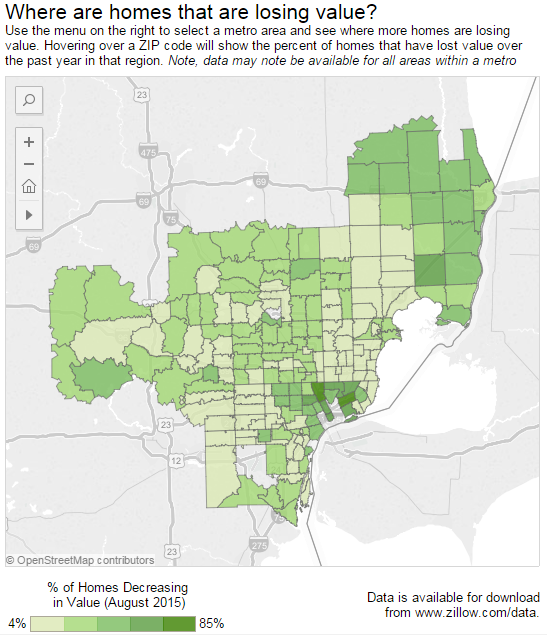New research finds investment in neighborhood stabilization pays off—and more is needed
October 9, 2015

 “House prices have sufficiently recovered and foreclosure activities have sufficiently abated.”
“House prices have sufficiently recovered and foreclosure activities have sufficiently abated.”
That was the faulty argument made this past July to support a U.S. Senate proposal that would have rescinded federal Hardest Hit Funds – a critical source of funding for neighborhood stabilization efforts in communities hit hardest by the foreclosure crisis – in order to help pay for a multi-year federal transportation bill.
Thanks to the work of Michigan and Ohio lawmakers, the threat to rescind this funding was removed before the transportation bill ever hit the floor for a vote. But the sentiment among some decision-makers remains, and sources of funding for neighborhood stabilization are in increasingly short supply.
Far from being unnecessary, Hardest Hit Funds and other federal, state, and local sources of funding are still critical. And new research shows that these investments pay off. To fully address the scale of vacant and abandoned properties in communities across the country, ongoing investment is sorely needed.
 The housing market has not “sufficiently recovered” in Detroit, nor in many of the country’s other hardest hit communities – many of which have been facing large-scale vacancy and abandonment for decades. Recently published data from Zillow shows a very uneven housing market recovery across the country. For example, from August 2014 to August 2015, 1.5% of homes in the Denver area saw a decrease in value, while a staggering 48.1% of homes in the Baltimore area lost value.
The housing market has not “sufficiently recovered” in Detroit, nor in many of the country’s other hardest hit communities – many of which have been facing large-scale vacancy and abandonment for decades. Recently published data from Zillow shows a very uneven housing market recovery across the country. For example, from August 2014 to August 2015, 1.5% of homes in the Denver area saw a decrease in value, while a staggering 48.1% of homes in the Baltimore area lost value.
And to add insult to injury, many communities that were flooded by mortgage foreclosures after the bubble burst are still being challenged by large and often growing inventories of tax-foreclosed properties. For the dedicated practitioners, policymakers, and community leaders working tirelessly to revitalize neighborhoods, the notion of an uneven recovery is hardly new.
The U.S. Treasury Department’s Hardest Hit Fund has been a critical resource for neighborhood stabilization, as its use in Detroit to keep residents housed through mortgage and tax foreclosure prevention, and to remove dangerous, blighted structures, demonstrates. New research commissioned by Rock Ventures, Inc. and the Skillman Foundation found that for every $1 spent toward demolition, the value of homes in the targeted demolition area increased by $4.27. The study examined the impacts of more than 3,000 strategically targeted Hardest Hit Fund demolitions performed by the Detroit Land Bank Authority between April 2014 and March 2015.
The research also demonstrates that demolition combined with other targeted interventions, such as nuisance abatement actions, land bank home sales, and side lot sales, created a 13.8% boost in home values. As a homeowner in one of these targeted areas of Detroit, I can say that the immediate physical improvement alone from these efforts makes a significant difference. Each burned out structure removed, lot cleaned and greened, land bank home renovated, and property secured contributes to a stronger and safer neighborhood. To learn more about these recent findings in Detroit, visit www.demolitionimpact.org.
Detroit is not the only city to see positive results from investments made in neighborhood stabilization. A number of communities have demonstrated the social and economic impacts of removing blight. For example, in Lansing, Michigan, homes located within 500 feet of a renovated Land Bank home increased an average of 5.2% in value. In Philadelphia, a study found that for every dollar spent to clean and green vacant lots, there was a $224 increase in housing wealth and $7.43 in resulting tax revenue. Other communities have experienced similar economic impacts as well as positive social impacts (like crime reduction) that can be attributed to communities’ focused revitalization efforts.
In order to see continued positive changes in our communities, leaders from the neighborhood level on up to the federal level must make stabilization and revitalization a priority – focusing the tools and resources already at hand, while simultaneously seeking out new and creative sources of support to fill the remaining gaps. And there are plenty of gaps.
Subscribe to join 14,000 community development leaders getting the latest resources from top experts on vacant property revitalization.
